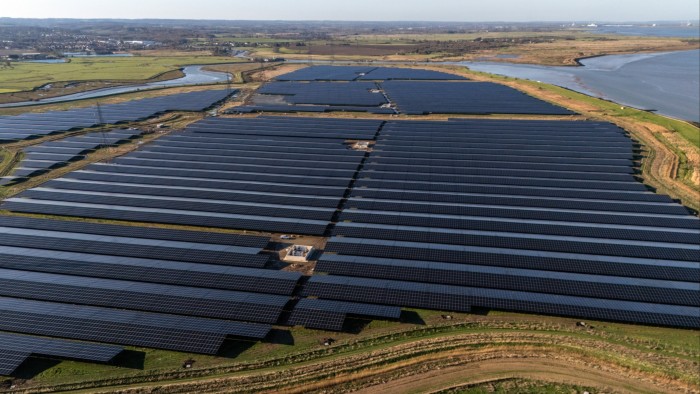Stay informed with free updates
Simply sign up to the Renewable energy myFT Digest — delivered directly to your inbox.
Renewable energy from wind, solar and hydropower will account for more of the UK’s electricity output this year than fossil fuels for the first time, according to think-tank Ember.
The green trio will account for about 37 per cent of the electricity generated this year, overtaking 35 per cent from fossil fuels, according to the study that includes production data and forecasts for the remainder of the year.
Wind power may even overtake gas as the largest single source of generation — though the final result for the year is too close to call.
The figures mark a major shift towards a lower carbon electricity system from a decade ago, when gas and coal accounted for almost 60 per cent of the country’s generation.
Frankie Mayo, senior climate analyst at Ember, said the figures were a “testament to how much progress the UK has made” following the closure of coal-fired power plants and the growth of wind turbines and solar panels. “The renewables future is here,” he added.
The government wants the UK to have an almost entirely “clean” power system by 2030, an extremely stretching target requiring rapid development of new infrastructure, and changes to consumer behaviour.
Labour’s election manifesto said it was aiming for “zero-carbon electricity” by 2030, although last week Sir Keir Starmer said it was now aiming for “95 per cent clean power by 2030”.
In a separate report published on Tuesday, Sam Hollister, head of energy economics at consultancy LCP Delta, said the 2030 target was “technically achievable” but that government, industry, regulators and investors would need to “move heaven and earth” to meet it.
He added that the further growth required beyond 2030, in order to meet the UK’s legally binding target of decarbonising the entire economy by 2050, was “arguably an even greater challenge”.
According to Ember’s analysis, 30.4 per cent of the UK’s electricity generation during 2024 will have come from gas-fired power stations, with wind only slightly behind at 29.34 per cent.
“Wind is well on its way to overtaking gas as the largest single power source, although with only 1 per cent difference in generation forecasts it is too close to call in 2024,” Ember added.
The findings classify nuclear power, which accounts for about 15 per cent of generation, separately, while some earlier studies that claimed UK renewables had overtaken fossil fuels included biomass, a process of burning wood pellets that produces carbon emissions.
The think-tank believes just 0.9 per cent of this year’s generation came from coal, 3.26 per cent came other fossil fuels such as waste or oil, 5.3 per cent from solar and 14.2 per cent from bioenergy.
The UK closed down its last coal-fired power plant at the end of September this year, the first G7 country to do so, after years of squeezing out the fuel through measures including high carbon prices.
It has meanwhile managed to boost wind and solar capacity through measures such as offering government guarantees on developers’ electricity prices, known as contracts for difference.
The government-owned National Energy System Operator, which was spun out of National Grid earlier this year, has indicated that gas supplies would account for up to 5 per cent of the UK’s generation in 2030, stepping in on windless days.
The finding is the main driver for the government’s decision last week to water down its electricity target to 95 per cent of generation coming from low carbon sources.
Even with gas available for back-up, hitting the 2030 goal will require “several elements [to] deliver at the limit of what is feasible”, NESO has said.
Read the full article here

